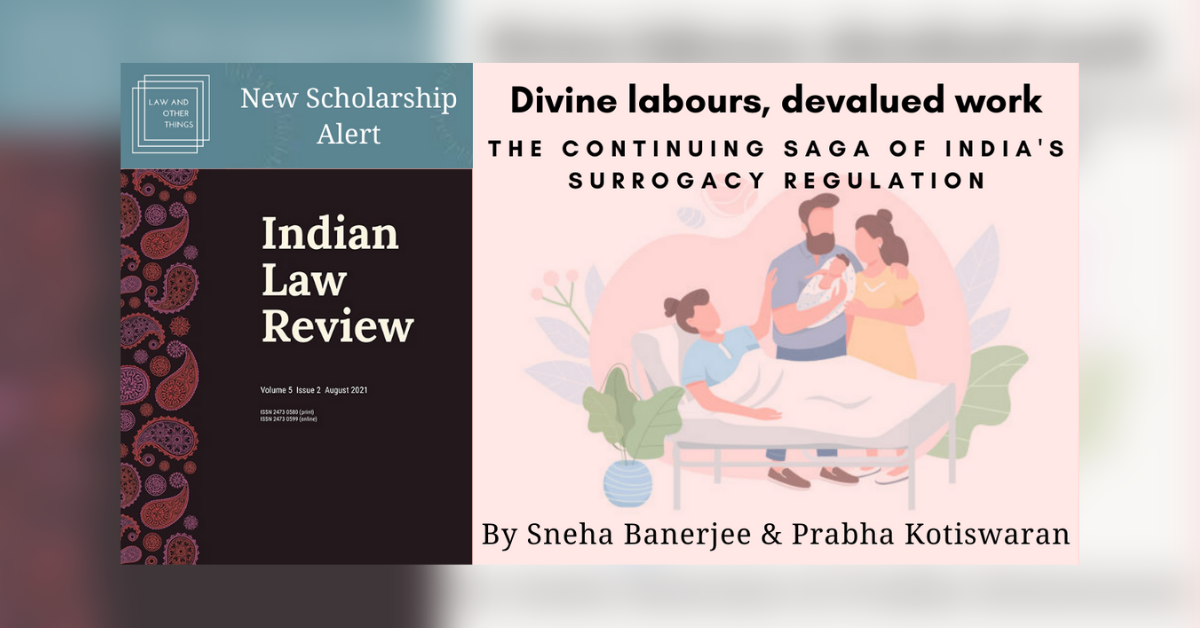Ed Note: As part of our New Scholarship section, we have been inviting discussants to respond to the public law themed articles featured in Volume 5 of the Indian Law Review. You can access all the posts in this discussion here. In this post, Sneha Banerjee and Prabha Kotiswaran respond to the discussion pieces by Chayanika Shah, Anindita Majumdar, Swati Gola, and Sharmila Rudrappa on their paper “Divine labours, devalued work: the continuing saga of India’s surrogacy regulation”. You can access the article here and the summary of the Paper here.
We thank Law and Other Things for this valuable opportunity to discuss our work with feminists and lawyers who we have admired for long. A special thanks also to Swati Gola, Anindita Majumdar, Sharmila Rudrappa and Chayanika Shah for their wonderfully insightful comments and provocations. We could not hope for more generous interlocutors. This conversation comes at an opportune time when the “muddled and confused” (as Shah aptly puts it) journey of the Assisted Reproductive Technology (Regulation) Bill 2021 (ART Bill) and the Surrogacy (Regulation) Bill 2021 (SRB) have come to a conclusion with both houses of Parliament approving them in December 2021. The SRB has been signed into law by the President and notified in the Gazette of India on December 25th, 2021. The Surrogacy (Regulation) Act, 2021 (SRA) is in force. Needless to say, we are disappointed with the outcome especially given that the sharp feminist critique of the various versions of the two Bills, right from the early 2000s, has gone largely unheard. The comments of our reviewers assume particular significance in light of this development. To clarify, the SRA is based on the version submitted by the Select Committee of the Rajya Sabha which we discuss in our article. The SRA no longer requires that the surrogate be a close relative, just that she be a willing woman. Similarly, it does not allow for compensated surrogacy and only the payment of medical expenses, costs and any complications. It does allow for a 36-month insurance policy in favor of the surrogate to include ‘prescribed expenses’ but what this means will be spelt out in delegated legislation.
We begin this response by reiterating the common threads between our argument and that of the respondents. We join voices with the respondents in arguing that it is imperative that the dissonances between the ART Bill and SRB be addressed (which unfortunately, has not been the case as the SRA comes into force), given the centrality of the use of ARTs in gestational surrogacy. We couldn’t agree more with Majumdar on her observation of the manifest arbitrariness of the SRB. Her point about affixing a criminal identity to persons rather than their acts is also very useful and is exactly how doctors in fertility clinics have been perceiving the proposed changes in the SRB. It is important to recognize that the law on surrogacy is deployed as an instrument of “heteronormativising” (as Shah succinctly puts it) the society and seeks to regiment the possibilities of alternative family forms outside the hetero-patriarchal frame. The “heterosexist criteria… and centrality of marriage” (to quote Rudrappa) that the law upholds, substantiates this patriarchal impetus. Shah’s characterization of the law as “actively preventing the use of technology to subvert some of the dominant social norms around parenthood”, as “reasserting patriarchies” and as “an extremely diabolical anti-feminist project of the State executed in the name of protecting the exploitation of women and children” is particularly insightful in this regard. Shah goes on to demonstrate in a fine-grained manner how it is exclusionary in relation to infertilities that are not merely of the kind that result from or can be identified as a “disease” but may be related to limitations or an exercise of choice around biological reproduction by individuals and couples who are outside the realm of heteronormative marriage, or as a result of their transgender identity. Shah’s reading of the prohibition of a medical professional from transferring a human embryo into a male person as a way of excluding transmen or male persons with intersex variations from carrying a pregnancy seems highly plausible. This is so, especially in light of the need to further clarify this in the SRA that embryos and oocytes be implanted into the uterus of the surrogate mother (earlier it referred to implantation in the surrogate mother). She very effectively demonstrates how there exists a complete mismatch between the two Bills on the one hand, and judicial pronouncements against discrimination on the basis of sexual orientation and gender identity viz. the reading down of IPC s. 377 and the Transgender Persons (Protection of Rights) Act, 2019 on the other.
Some of the respondents have also raised critical points regarding rights of the child(ren) born out of surrogacy. In our article, this was not a focus area and hence we haven’t dealt with the question in any depth. However, this is an opportunity to engage with this question, albeit briefly. Shah has highlighted how there is a need to bring the ART Bill & SRA to work in tandem with the law of the land on children’s identity, guardianship, and related issues. Rudrappa brings in the citizenship question (with the acknowledgement that it may not remain as big a concern anymore since foreign nationals are prohibited under the new law). But given that OCIs are still allowed to enter into surrogacy arrangements, it is important to address that question. She mentions our identification of the lack of precision in the legislation on the need for a genetic link between at least one parent and the child as it is in some other countries. We however, do not make an argument either for or against such a requirement. We merely underline this as an aspect that should be addressed and how it has been done in other jurisdictions. We have also argued elsewhere[1] that children ought to have the right to know about the use of ARTs and/or surrogacy in their births. Both the ART Bill and the SRA are thin on their protections of children’s rights. We are quite sympathetic to Rudrappa’s call to not insist on genetic linkages. Unfortunately, the recommendation of the Law Commission of India to include such a linkage has assumed authority although the SRA does not require this. Additionally, Rudrappa queries whether birthright citizenship can be explored in this context instead of the genetic link route that has been fraught with instances of mishandling and faulty results when consulates/embassies of different countries evoked that condition when transnational commercial surrogacy was allowed in India. Section 3(1)(c) of the Citizenship Act, 1955 stipulates the conditions under which a person can be a citizen of India. Under the section, persons born in India shall be citizens at birth where both of their parents are citizens of India or where one of their parents is an Indian citizen and the other is not an illegal migrant at the time of their birth. It does not however define the term ‘parent’. Since PIOs and OCIs can commission surrogacy under the SRA, bringing the children born out of surrogacy within the fold of birthright citizenship is certainly an interesting avenue to explore.
In the next part of this response, we take the opportunity to engage with some of the specific issues that our respondents have raised.
Shah makes a case for separately dealing with regulation of technology and its provisioning & regulations around people who can access the said technology. This is a provocative idea which we need to engage with. If and when the ART Bill and SRA are challenged for violating the Constitution by excluding the LGBTQIA community, this argument must be made before the courts. However, the risk of delinking the regulation of technology and who can access this technology is that Indian family law itself does not permit certain forms of social contracts (e.g. same sex marriage contracts), and the law lags behind social realities. Until a time when all laws are aligned with constitutional pronouncements on same sex equality, amplifying the dissonance between a law on technology and constitutional law will help inspire change in family law and vice versa.
Majumdar highlights the need to foreground an understanding of kinship and the idea of “kutumb” as a safe haven for gift-giving transactions. We agree with her that it is integral to the way the question of altruistic vs. commercial surrogacy is envisioned in the law (resonances can be seen in the Transplantation of Human Organs and Tissues Act, 1994, as she highlights). We also share her concern regarding intrafamilial coercion and exploitation that comes with altruistic surrogacy through a close relative. Hence, we view altruistic surrogacy as violating Article 23 of the Constitution prohibiting forced labour because force exerted by the family is on par with force exerted by the market.
Rudrappa asks if making a case in favour of compensated surrogacy as we do, potentially transforms the nature of the transaction in gestational surrogacy, especially when it is between “close relatives” (albeit undefined) from gift-giving to commodity form? Interestingly, although the SRA now allows any “willing woman” and not just a “close relative” to act as a surrogate, given that only altruistic surrogacy is permitted, the surrogate is de facto likely to be a close relative or a reproductive labourer who has a pre-existing relationship with the commissioning parties (e.g. paid domestic worker). The deeply unequal relationship between the commissioning parties and the surrogate will persist albeit through a different set of social relationships (e.g. in the case of a domestic worker). The problem that Rudrappa poses is therefore a significant and persistent one.
However, she seems to presume that regulatory models have a fixed form and that they bear a necessary relationship to social arrangements. Hence, her statement that the “commodity form [is one] wherein the law governs only the act of exchange of gestational labour for a baby” or that altruistic surrogacy is patterned on gift giving. However a statute is always a highly contingent complex of legal rules. A model permitting commercial surrogacy could just as well mandate continued social relationships between the parties long after the baby is handed over rather than allowing for “momentary, transient connections between buyer and seller” (as indeed was evident in some instances of commercial surrogacy in India during the heyday of its transnational phase). It could have also provided for the formation of surrogates’ cooperatives or associations whereby they were recognised as workers who could collectivise for better working conditions but also for sustained contact with the children that they gave birth to. Conversely, an altruistic model could be deeply indifferent towards the surrogate as is evident in the SRB and SRA where only her minimum medical needs are provided for and she is otherwise denied any agency and voice, always already a subject of ‘exploitation’ in the surrogacy arrangement. Alternatively, consider the Parliamentary Standing Committee report on the Surrogacy (Regulation) Bill, 2016 which embodied a refreshingly different imagination of how surrogacy should work, a model Kotiswaran[2] called proto-socialist for its abiding promotion of the rights of surrogates and active intervention by the state in facilitating surrogacy by empanelling surrogates and fixing their levels of compensation which in turn would have had a positive effect on their mobilisation. Ultimately, empowering surrogates is the only way to begin to address power imbalances between commissioning parties, clinics and surrogates whether surrogacy is commercial, compensated or altruistic. The law offers a powerful tool for rearranging these social relations. And there is no better testament to the contingency of regulatory models than the numerous legislative proposals which we have seen in India since 2005. Thus the effect of compensated surrogacy on social relationships between the various parties depends on what other levers of power the law seeks to activate through regulation of various aspects of the relationship other than compensation.
Moreover, for Rudrappa, our comparison between different jurisdictions seems non-cognisant of cultural specificities, and she suggests that rather than lessons in what to do, such comparison seems to yield what “not to do” in terms of lessons for law-making. She even argues that perhaps non-regulation of surrogacy is better, when the impulse of law-making seems to be highly restrictive of women’s autonomy in light of recent anti-abortion law in Texas, US where Rudrappa is located. However viewing the question as legal realists, we see that no social reality is ever unregulated by the law; the lack of a surrogacy law is not something to be celebrated because existing laws already determine bargaining powers between contracting parties in ways that disempower surrogates undertaking pregnancies for domestic commissioning parties. A surrogacy law will redistribute bargaining powers of various stakeholders. Hence a regulatory vacuum is not necessarily a good outcome because it is a mirage to begin with.
This brings us to the argument about surrogacy contracts that Gola highlights. She asks how is a contract going to be effective when it is entered into amidst asymmetrical power relations? She emphasizes that it is bound to be an unequal arrangement unless independent legal counsel is organized for the surrogate too. We agree with the need to provide such counsel to the surrogate and underscore the argument that unequal bargaining power does not mean that there should be no contract between two parties. Instead, we know that labour law shows us an excellent way forward to enable collective bargaining. There is no reason why surrogates cannot form unions or cooperatives to set the terms of their engagement. Indeed, in many ethnographic accounts of surrogacy, surrogates have bargained for higher payments (including on a clinic wide basis) especially when they have had to carry twins. Further, Gola probes the theoretical foundations for the invocation of a link between surrogacy and the case-law on unpaid work by homemakers and its extension to award of compensation for the loss of foetus too. We didn’t have the space to go into this in this article because we were keen to critique the SRA and its violations of the Constitution but there is extensive recognition of the unpaid domestic and care work of women in the context of tort law where courts have had to decide how to value women’s reproductive labour upon her death. The decision which awarded compensation for loss of foetus did not offer a lengthy exposition on this point but simply extended existing jurisprudence on women’s unpaid work within the home. Kotiswaran[3] has written more about this case law elsewhere. Lastly, in relation to Gola’s interpretation of our argument on reproductive autonomy, we have not endorsed the idea that commissioning parties have an unfettered right to reproduce. In fact, we argue that it needs to be balanced vis-à-vis the surrogate’s reproductive autonomy and that any contractual arrangement between them is likely to be highly unequal. In other words, reproductive justice is truly possible only when structural barriers to reproductive health are addressed and not when lip service is paid to the divine nature of women’s labour.
We once again thank Law and Other Things for this opportunity and look forward to future conversations as the ART Bill comes into force and the SRA is implemented.
[1] Kotiswaran and Banerjee (2022; forthcoming), “Counterproductive Regulation of Assisted Reproductive Technologies: A Review of the Assisted Reproductive Technologies Bill, 2020”, National Law School of India Review, 33(2); Advance access copy: https://nlsir.com/counterproductive-regulation-of-assisted-reproductive-technologies-a-review-of-the-assisted-reproductive-technologies-bill-2020/ (Accessed on 23 December 2021)
[2] Kotiswaran, Surrogacy Regulation is Stuck Between Market, Family and State, March 28, 2018, https://thewire.in/women/stuck-between-market-family-and-state-empower-surrogates-themselves[3] Kotiswaran, Prabha (2021), “Ode to Altruism: How Indian Courts Value Unpaid Domestic Work”, Economic and Political Weekly 56(36).
Sneha Banerjee is an Assistant Professor at the Department of Political Science, University of Hyderabad. Prabha Kotiswaran is a Professor of law and social justice at the Dickson Poon School of Law, King’s College London, United Kingdom. More work by the authors on surrogacy regulation can be found here, here and here. The authors can be contacted at snehabanerjee@uohyd.ac.in and prabha.kotiswaran@kcl.ac.uk.






Thank you for your sharing. I am worried that I lack creative ideas. It is your article that makes me full of hope. Thank you. But, I have a question, can you help me?